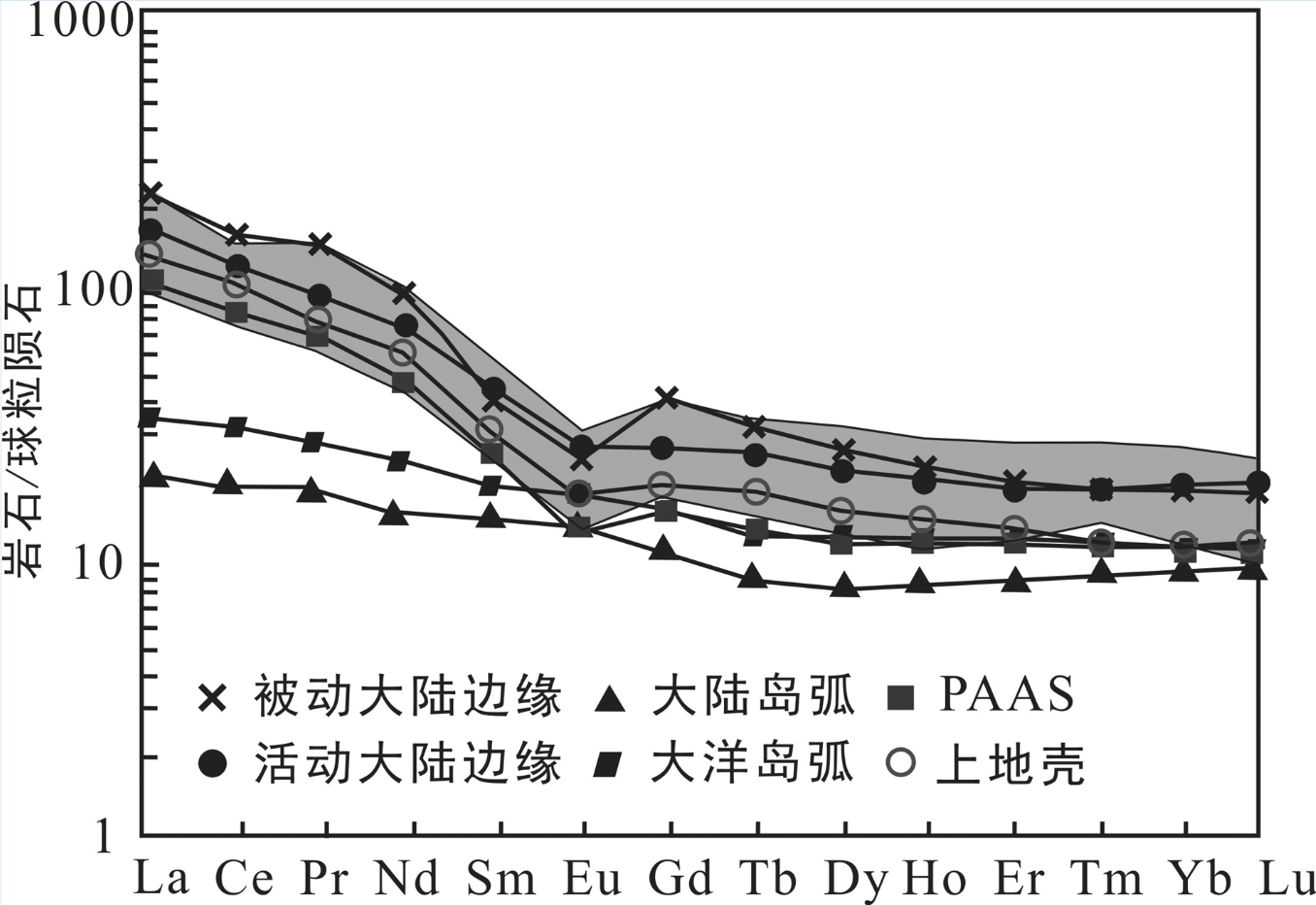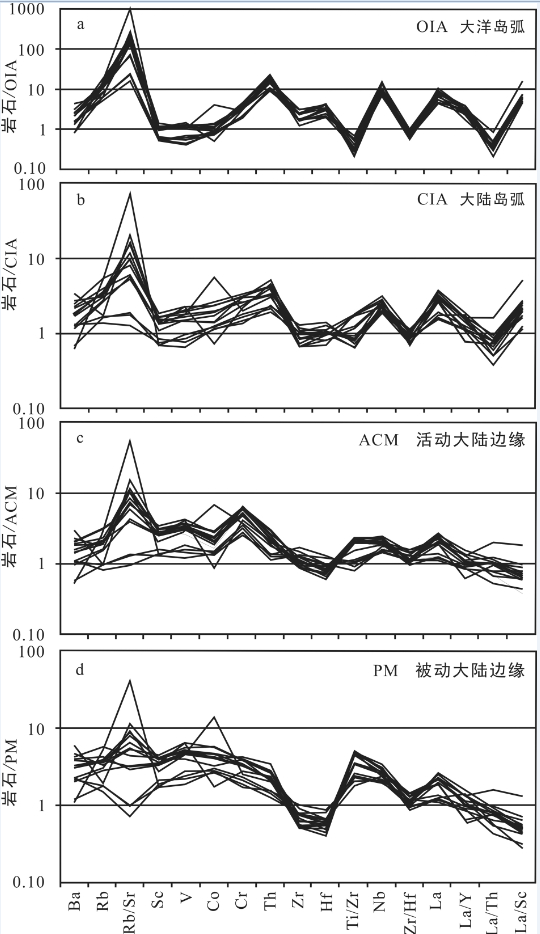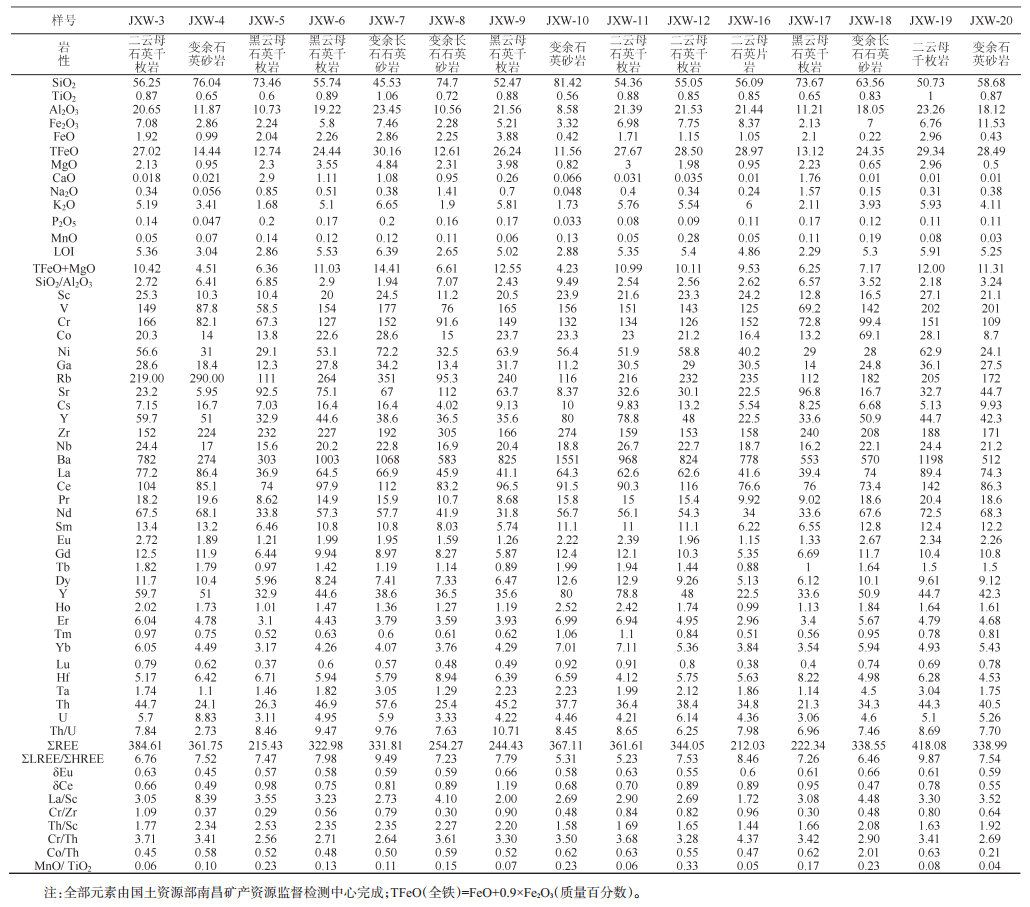2. 江西省地质调查研究院, 江西 南昌 330030;
3. 江西省地质矿产勘查开发局赣东北大队, 江西 上饶 334000
2. Geological Survey Institute of Jiangxi Province, Nanchang 330030, Jiangxi, China ;
3. Northeast Jiangxi Geological Party, Jiangxi Bureau of Geology and Mineral Exploration and Development, Shangrao 334000, Jiangxi, China
华南由扬子地块和华夏地块沿早新元古代江南造山带拼合而成。长期以来,华南早古生代构造属性一直存在诸多观点。从岩浆岩的角度,主要争论有2种观点:①扬子与华夏是板块碰撞造山拼合,先期存在一个已消失的大洋[1-11]。②扬子与华夏在早古生代不存在大洋俯冲,只是陆内地块之间相互作用的陆内造山[12-21]。争论的焦点之一,为华南是否存在一个已经消失的早古生代大洋板块。因此,震旦纪至早古生代期间盆地性质的厘定,一定程度上成为华南大地构造属性研究的重点。前人的研究多集中在岩浆岩方面,近年有部分研究人员从沉积岩的角度进行了研究与讨论,如湘东南地区[19]、湘桂交界及湘南地区[22]、赣西南地区[18, 23],以及华夏腹地江西南部早古生代沉积岩[13, 21]。笔者在详细的野外地质调查基础上,对江西南部新元古代—早古生代南城—寻乌盆地震旦纪寻乌岩组变沉积岩进行了系统的主量元素、微量元素和稀土元素地球化学研究。在通过地球化学特征判别震旦纪变沉积岩构造环境基础上,从沉积岩物源和构造环境的角度,结合当前华南地质研究的新进展,探讨了华南新元古代—早古生代的构造背景,为华南早古生代构造环境与构造演化提供新资料。
已有研究表明,碎屑沉积岩的化学组成记录了源区成分特征、物源区古风化条件和大地构造背景等方面的信息[24-26]。碎屑岩的地球化学特征主要受源区成分控制[27],一些微量和稀土元素在搬运、沉积、成岩的过程中一般不会发生明显的变化[26]。因此,可以利用碎屑沉积岩的地球化学特征来判别其物源与形成的构造背景。
2 地质概况研究区位于江西省南部寻乌—会昌—安远—定南一带,其大地构造位置位于华南加里东造山带东段[28](图 1-a)。研究区属于华南地层区的南武夷小区[29],出露的地层除了寻乌岩组外,还有南华纪沙坝黄组,震旦纪坝里组、老虎塘组。寒武系牛角河组、高滩组、水石组。中生代火山盆地发育,主要为侏罗纪菖蒲组—早白垩世鸡笼嶂组等火山碎屑岩和晚白垩世红盆沉积。

|
图 1 江西南部寻乌岩组分布地质简图(据江西省1:50万地质构造图修改) Fig.1 Regional geological distribution map of Xunwu Formation in southern Jiangxi Province (modified after 1:500000 geological Structure Map of Jiangxi Province) 1—沙坝黄组;2—坝里组;3—老虎塘组;4—寻乌岩组;5—牛角河组;6—泥盆系;7—菖蒲组;8—鸡笼嶂组;9-晚白垩世红层沉积;10—新元古代侵入岩;11—泥盆纪侵入岩;12—石炭纪侵入岩;13—印支期侵入岩;14-燕山期侵入岩;15—不整合接触界线;16—断层;17—糜棱岩带;18—剖面编号及采样点位置 1-Shahuangba Formation; 2-Bali Formation; 3-Xunwu Formation; 4-Niujiaohe Formation; 6-Devonian strata; 7-Changpu Formation; 8-Jilongzhang Formation; 9-Late Cretaceous red beds; 10-Neoproterozoic intrusive rocks; 11- Devonian intrusive rocks; 12-Carboniferous intrusive rocks; 13-Indosinian intrusive rocks; 14-Yanshanian intrusive rocks; 15- Unconformity; 16-Fault; 17-Mylonite zone; 18-Serial number of geological section and sampling site |
岩浆岩发育,以中生代花岗岩为主,出露许多加里东期岩体。局部分布新元古代片麻状花岗岩、糜棱岩化花岗岩。断裂构造发育,以寻乌—瑞金断裂为代表,控制着区内岩浆活动、锡铜等矿床及沉积活动[30]。
寻乌岩组由赣南地质调查队1997年❶创名,层型地在寻乌县吉潭镇,而区域上则主要沿北东方向呈长条带形分布于江西南部寻乌—会昌—安远—定南一带,往东北可以延伸到福建的建宁、邵武一带,与震旦-寒武纪浅变质地层呈断层接触,且多被不同时期的花岗岩侵入[31](图 1-b)。以往对该套变沉积岩研究较为薄弱。前人认为,寻乌岩组主要岩石类型有片岩、片麻岩、变粒岩夹石英岩及灰岩透镜体,局部有变质较浅的千枚岩,变质程度达低角闪岩相,笼统地归为前震纪❶。开展隘高圩幅和鹤仔圩幅1∶5万区调工作时,前人认为原寻乌岩组仅相当于测区中深变质岩层的一部分,改名寻乌岩群,成岩时代归为古元古代,认为是本区古老结晶基底[31]。为了与江西省区域地质志命名一致,本文仍称其为寻乌岩组。
❶江西省地质矿产能勘查开发局. 1:5万寻乌县幅地质图说明书(内部资料),1997.
笔者在进行详细的野外地质调查时发现,在寻乌、澄江一带寻乌岩组为一套基本有序绿片岩相浅变质岩系,其岩性组合为粉砂质千枚岩、变余石英岩屑砂岩夹薄层状灰白色硅质岩,局部偶夹构造片岩(图 2),见有较明显的角岩化。局部变形变质稍强,可能与区内北东向深大断裂及后期岩浆侵入有关,而非区域变质作用所致。其岩性组合可与区域上震旦纪坝里组、老虎塘组进行对比,尤其是灰白色薄层状硅质岩可与老虎塘组硅质岩进行良好的对比[29]。

|
图 2 寻乌、澄江一带寻乌岩组变沉积岩野外露头照片 Fig.2 Field photographs of the meta-sedimentary rocks from the Xunwu Formation in the Xunwu-Chengjiang area a—变余石英砂岩与黑云母千枚岩互层;b—变余石英砂岩夹硅质岩;c—二云母千枚岩夹硅质岩;d—变余长石石英砂岩 a-Palimpsest quartz sandstone interbedded with biotite phyllite; b-Palimpsest quartz sandstone with siliceous rocks; c-Two mica phyllite; d-Feldspathic quartz sandstone |
王丽娟等[32]对赣南鹤仔镇寻乌岩组1个黑云斜长片麻岩进行碎屑锆石年代学研究,获得最年轻锆石年龄615 Ma。江西省第二代区域地质志❷根据寻乌岩组原岩特点,将其时代暂定为南华纪晚世—震旦纪。最近,笔者系统地对寻乌岩组3个样品进行LA-ICP-MS碎屑锆石U-Pb年代学研究,获得了一批高精度年龄值,其最年轻锆石年龄分别为602Ma、596 Ma、570 Ma(详细数据拟另撰文),从而限定了寻乌岩组成岩时代下限,表明其沉积时代晚于570 Ma。笔者对水源乡附近侵入于寻乌岩组中的岐山岩体1个样品进行了同位素年龄测试,获得了其结晶年龄458 Ma(详细数据拟另撰文)。因此,寻乌岩组变沉积岩沉积时代为570~458 Ma。结合其野外特征及岩性组合,将其时代暂定为震旦—寒武纪。
❷江西省地质矿产勘查开发局.江西省第二代区域地质志(未正式出版资料),2015.
3 分析测试和岩石地球化学特征 3.1 样品采集与分析方法笔者沿寻乌县吉谭镇寻乌岩组典型剖面自下而上进行了系统采样(图 3),样品包括变余石英岩屑砂岩、二云母石英片岩、云母石英千枚岩等,在系统的岩相学鉴定的基础上,选取15件样品(变余砂岩6件,千枚岩8件,片岩1件),开展了主量、微量和稀土元素的测试分析工作,测试由国土资源部南昌矿产资源监督检测中心完成。FeO采用50 mL滴定管方法检测,烧失量(LOI)采用重量法检测,其余元素采用波长色散型X射线荧光光谱仪测定,精度优于2%~5%;微量元素和稀土元素采用FinniganElementⅡ型电感耦合等离子体质谱仪(ICP-MS)测定,检测限优于0.5×10-9,相对标准偏差优于5%,结果见表 1。

|
图 3 江西省吉潭镇寻乌岩组地层采样位置地质剖面简图(A-梧桐坳剖面;B-杨梅坑剖面) Fig.3 Geological sections with sampling locations from Xunwu Formation in Jitan Town, Jiangxi Province (A-Wutongao section; B-yangmeikeng section) 1—变余石英砂岩;2—变余长石石英砂岩;3—粉砂质千枚岩;4—二云母千枚岩;5—二云母石英千枚岩;6—黑云母石英千枚岩;7—二云母石英片岩;8—硅质板岩;9—硅质岩;10—变余长石砂岩;11—炭质板岩;12—砂质板岩;13—印支期二长花岗岩;14—寒武纪牛角河组;15—寻乌岩组;16—断层;17—采样位置及编号;18—产状 1-Palimpsest quartz sandstone; 2-Feldspathic quartz sandstone; 3-Quartz phyllite; 4-Two mica phyllite; 5-Two mica quartz phyllite; 6-Biotite quartz phyllite; 7-Two mica quartz schist; 8-Silicified slate; 9-Siliceous rock; 10-Arkose; 11-Carbonaceous slate; 12-Sandy slate; 13-Indo-Chinese monzonitic granite; 14-Cambrian Niujiaohe Formation; 15-Xunwu Formation; 16-Fault; 17-Sampling position and its serial number; 18-Attitude |
|
|
表 1 寻乌岩组变沉积岩样品主(%)、微量元素(10-6)分析数据 Table 1 Major(%) and trace element (10-6) data of the meta-sedimentary rocks from the Xunwu Formation |
由表 1可知,寻乌岩组变沉积岩样品的SiO2含量变化范围较大,除样品XW-7含量较低外,其余样品SiO2含量平均为63.01%,略低于中国东部上地壳(65.46%)与上地壳(66%),接近于后太古宙澳大利亚页岩(PAAS)(62.80%)。样品具有较高的K2O、Al2O3含量,较低的Na2O、CaO含量。
代表相对基性组分的(TFeO+MgO)含量较高(TFeO指以Fe2O3形式表示的全铁含量),主要变化于4.23%~14.40%,平均9.16%,大部分样品明显高于中国东部上地壳(7.89%)与上地壳(6.7%),接近于PAAS(9.35%)。
通常情况下,SiO2/Al2O3值可以反映沉积岩成熟度[26]。样品SiO2/Al2O3值变化于1.94~9.49,平均为4.2,成熟度属于中等。
3.3 微量元素特征样品大离子亲石元素含量变化较大(表 1)。与PAAS相比,Ba、Rb含量总体相当,Th富集,而Sr、CaO明显亏损(图 4-a)。与中国东部上地壳、上地壳相比,大部分样品Ba、Rb、Th富集,而Sr、CaO亏损(图 4-b、c)。其高场强元素含量均较高,与中国东部上地壳、上地壳及PAAS相比,Zr、Hf、Nb、Ta、Y富集(图 4)。大部分样品相容元素(Cr、Ni、Co、V、Sc)含量与PAAS含量十分接近,高于中国东部上地壳与上地壳。

|
图 4 寻乌岩组变沉积岩与PAAS(a)、上地壳(b)、中国东部上地壳(c)多元素标准化图解 Fig.4 Normalized multi-elements diagrams of the metasedimentary rocks from the Xunwu Formation compared with PAAS (a), the upper continental crust (b), and the EC (c) (PAAS、上地壳数值据文献[26];中国东部上地壳数值据文献[33]) (PAAS and the upper continental crust data after reference[26]; EC data after reference [33]) |
样品稀土元素总量(ΣREE)变化较大,明显高于上地壳(146×10-6)及PAAS(183×10-6)(表 1,图 5)。样品轻稀土(LREE)中等富集,(La/Yb)N的值为5.94~13.0,平均为8.69,ΣLREE/ΣHREE比值为5.23~9.87,平均为7.46。轻稀土分异相对较大,(La/Sm)N值为3.54~4.54,平均为3.86,而重稀土分异较小,(Gd/Yb)N值为1.11~2.15,平均为1.60。样品均具有明显Eu负异常(δEu=2EuN/(SmN+GdN)=0.45~0.66,平均为0.59。Ce异常总体较弱,δCe值总体变化于1.19~0.66。

|
图 5 寻乌岩组变沉积岩稀土元素球粒陨石标准化配分曲线图 Fig.5 Chondrite-normalized REE patterns of the metasedimentary rocks from the Xunwu Formation (球粒陨石标准化数值、PAAS、上地壳数值据文献[26];不同构造环境数值据文献[25];) (chondrite normalized data, PAAS and the upper crust data after reference [26]; various tectonic conditions data after reference[25]) |
稀土元素球粒陨石标准化配分模式具有相似性,都为明显向右倾型、轻稀土中等富集、轻稀土分异相对较大、重稀土分异较小与Eu负异常明显、Ce异常较弱等特征,相似于典型的PAAS与上地壳特征[26]。
4 讨论在运用元素作为确定沉积物源区判定指标时,有必要对物理风化、化学风化、变质等过程中元素的相对活动性进行评估[34]。在活动元素不断加入或释放等过程中,不活动元素由于具有相似的流体动力学行为,因此,其具有相对稳定的比值,并且元素间的含量呈现出较好的线性相关,然而活动元素分布却非常分散[35]。寻乌岩组变沉积岩大部分样品TFeO、TiO2、Al2O3之间呈现出较好的线性相关(图 6),表明Fe、TiO2、Al2O3较为稳定。

|
图 6 寻乌岩组变沉积岩Al2O3-TFeO(a)、 Al2O3-TiO2(b)和TFeO-TiO2(c)图解[36] Fig.6 Al2O3-TFeO(a), Al2O3-TiO2(b) and TFeO-TiO2(c) diagrams of the meta-sedimentary rocks from the Xunwu Formation[36] |
考虑到本次研究所采集样品遭受到了不同程度的风化淋滤作用与浅变质作用,活动性较强的元素可能在岩石风化、变质过程中发生迁移、淋滤丢失。因此,本文避免使用活动性较强的元素,而使用不活动元素作为判定沉积物源区及构造环境的指标。
4.1 源区特征利用四种元素构筑的两元混合模型,可以较好地识别是否存在源区内不同端元组分混合或不同源区组分混合及其混合端元的某些成分标志[26]。某些不活泼元素Th、Sc、Co、Cr和稀土元素在水体中具有低的分配系数和滞留时间,且变质作用对这些元素影响较小,因此它们的组合特征不但可确定沉积物源区类型,而且能有效地确定沉积盆地的构造环境[24-25]。La、Th常赋存于酸性岩,Zr主要存在于锆石中,而Sc、Cr、Co富集于基性岩中,因此,Cr/Zr、La/Sc、Th/Sc、Cr/Th、Co/Th的比值能反映沉积源岩区镁铁质与长英质物质的相对比例[37-38]。
在Th/Co-La/Co图解中(图 7),样品分布于3个区域内,暗示其可能具有多个物源区。从表 2中可以看出,样品上述元素比值全部落入长英质源区砂岩范围内,与镁铁质源区砂岩明显不同,反映其物源区以长英质岩石为主。在Ni-TiO2图解中(图 8),大部分样品落入长英质区内及附近,同样表明其物源以长英质岩石为主,部分落入长英质与镁铁质中间区域,个别较靠近镁铁质区域,表明物源区具有少量中基性组分,与样品较高(TFeO+MgO)值及相容元素富集的特征相吻合。

|
图 7 寻乌岩组变沉积岩La/Co-Th/Co图解[39] Fig.7 La/Co-Th/Co diagram of the meta-sedimentary rocks from the Xunwu Formation[39] |
|
|
表 2 寻乌岩组变沉积岩微量元素判别比值 Table 2 Discriminating ratios of trace elements of the meta-sedimentary rocks from the Xunwu Formation |

|
图 8 寻乌岩组变沉积岩Ni-TiO2图解[18] Fig.8 Ni-TiO2 diagram of the meta-sedimentary rocks from the Xunwu Formation[18] |
从La/Th-Hf图解中(图 9-a)可以看出,样品主要落入上地壳区域内的长英质源区附近。2个样品落在长英质源区右侧,暗示有古老的上地壳沉积物的加入[41]。在Co/Th-La/Sc图解中(图 9-b),绝大部分样品落入花岗岩、长英质火成岩与TTG平均成分区。

|
图 9 寻乌岩组变沉积岩Hf-La/Th(a)和La/Sc-Co/Th(b)图解(a据文献[26];b据文献[36]) Fig.9 Hf-La/Th(a) and La/Sc-Co/Th(b) diagrams of the metasedimentary rocks from the Xunwu Formation (a, afterreference [26]; b, after reference [36]) |
稀土元素球粒陨石标准化配分模式与典型的上地壳、PAAS稀土配分模式相似,同样反映其主要来源于上地壳(图 5)。
已有研究显示,华夏地块南部新元古代晚期—寒武纪碎屑沉积物源区为华夏地块东南部,而非扬子地块东南缘的江南造山带[13, 21, 23, 32, 42-43]。因此,其主要物源为研究区南部被改造的上地壳长英质和花岗质物源区,少部分物源为基性火山岩。
4.2 构造环境判别从最具构造环境判别意义的微量元素化学参数与不同构造环境标准化图解(图 10)可以看出,寻乌岩组各项参数明显不同于岛弧,而与大陆边缘具有一定的相似性。

|
图 10 寻乌岩组变沉积岩多元素标准化图解(不同构造环境数值据文献[25]) Fig.10 Normalized multi-element diagrams of the metasedimentary rocks from the Xunwu Formation (various tectonic environment data after reference [25]) |
通过寻乌岩组变沉积岩稀土元素球粒陨石标准化配分模式与不同构造环境配分模式对比(图 5),可以看出其配分模式与大陆边缘,尤其是与被动大陆边缘非常相似,而明显区别于大陆岛弧和大洋岛弧。
在La-Th-Sc构造环境判别图中(图 11-a),绝大多数样品落入活动大陆边缘和被动大陆边缘的混合区域及附近,少量落入大陆岛弧区域内。在La/Y-Sc/Cr图解中(图 11-b),大部分样品落入被动大陆边缘区域内,部分落入被动大陆边缘区上方,2个落入大陆岛弧区域内。

|
图 11 寻乌岩组变沉积岩构造环境判别图[25] Fig.11 Tectonic discrimination diagrams of the meta-sedimentary rocks from the Xunwu Formation[25] A—大洋岛弧;B—大陆岛弧;C—活动大陆边缘;D—被动大陆边缘 A-Oceanic arc; B-Continental arc; C-Active continental margin; D-Passive continental margin |
在利用沉积岩地球化学组成判别沉积盆地构造环境时,应注意到2个方面影响因素:一是物源区的物质组成,二为风化、搬运、沉积和成岩后作用。因此,对地球化学元素分析时,应考虑到沉积岩既具备物源区继承性构造环境特征,又具备同沉积时期的构造环境信息[19]。
由于岛弧环境的特殊性使得在岛弧环境下形成的陆源碎屑沉积岩具有非常特别的化学特征,并且不具有较多被动大陆边缘信息,而被动大陆边缘由于物源的复杂性,未经历强烈再循环作用的沉积物往往继承了原岩形成时的大陆岛弧型或活动大陆边缘的微量元素信息[19, 44]。前已论述,寻乌岩组变沉积岩具中等成熟度,可能未经历强烈再循环,导致部分样品继承了源岩地球化学信息。因此,寻乌岩组变沉积岩应形成于靠近被动大陆边缘环境。值得指出的是,据上述物源区分析,其物源为上地壳长英质和花岗质物源区,少部分物源为基性火山岩,这与一般的被动大陆边缘发育巨厚层浅海相沉积,岩浆活动微弱等特征相吻合。魏震洋等对华夏地块南岭地区新元古代变质岩的研究也得出相似的结论[45]。
沉积岩Ce负异常的存在与否及其强弱变化是判断沉积环境的重要标志[46-47]:在大陆边缘附近,Ce负异常不明显(0.84~0.93)或出现正异常;在开阔大洋,负异常明显(0.56±);在洋中脊附近,负异常最显著(0.28±),由表 1和图 5所示,Ce异常不明显,平均值为0.85,表明其形成于靠近大陆边缘浅海环境。MnO/TiO2比值是一个有效的判断沉积环境的地球化学标志[48],在海沟至深海范围内,MnO/TiO2比值大于0.5;在陆架和陆波范围内,其值小于0.5;在近岸浅海陆架内,该值最低(<0.2)。由表 1可知,绝大部分样品MnO/TiO2比值小于0.2,平均为0.14,同样反映沉积环境为近岸浅海。
南北向的南城—寻乌盆地,为武夷陆块与赣中南陆块的分界[14],该盆地被震旦纪—晚奥陶世浅海—半深海相泥砂质碎屑岩充填,发育大量浅海相沉积构造或标志[13],但缺少同时期的火山喷发或基性岩浆侵入活动[14]。结合上述寻乌岩组各种地球化学参数与不同构造环境相应特征参数的比较,可以确定新元古代—早古生代南城—寻乌沉积盆地不是大洋而是浅海—半深海,其构造环境应属于发育有裂谷系的被动大陆边缘,与舒良树[14]、杨明桂[49]、张国伟[50]等人的认识一致。
柏道远等[19]对湘东南南华系—寒武系砂岩研究表明其形成于被动大陆边缘环境,扬子地块与华夏地块之间新元古代—早古生代期间的沉积盆地不是洋盆,而是陆内裂谷盆地。王鹏鸣等[22]对湘桂交界及湘南地区新元古代浅变沉积岩进行了岩石地球化学研究,得出研究区震旦—寒武纪的沉积盆地应位于被动大陆边缘的结论。杜晓东等[51]对广西大瑶山—大明山地区寒武纪砂岩-泥岩的地球化学特征研究表明其区内寒武纪碎屑岩成分主要代表了被动大陆边缘浅海环境物源,早古生代岩石中不存在反映“华南洋”洋壳成分的地球化学证据。
郑宁等[23]对赣西南下寒武统杂砂岩地球化学与沉积环境进行了研究,结果显示赣西南下寒武统杂砂岩具有被动大陆边缘的地球化学特征,部分样品反映活动大陆边缘特征,总体可明显与岛弧环境相区别,水体较深,而且自南向北略微加深。
沈渭洲等[18]通过对江西井冈山地区早古生代沉积岩地球化学的研究,结合地质学证据,认为江西井冈山地区早古生代沉积盆地属于浅海-半深海或陆壳海槽环境,不是大洋,其构造环境应属于被动大陆边缘。对原所谓“古华南洋”区及两侧广泛区域的碎屑锆石的研究表明,其碎屑锆石普遍具有相似的年龄谱系[52],为无大洋分隔的陆内海盆环境。古生物地层与古生态生物学研究表明雪峰以东至井冈山、赣州间的古生物地层沉积与笔石古生物都具有连续性[53-54]。
总之,多学科研究说明华南大陆在早古生代时期是连续统一的大陆,中间并无洋盆的记录,而只是从南华纪以来由裂谷盆地连续演化而来的华南早古生代陆内统一海盆。
本文对江西南部震旦—寒武纪寻乌岩组进行地球化学特征研究,得出其形成于被动大陆边缘浅海—半深海环境的认识,从沉积岩地球化学方面为华南早古生代构造属性提供了新资料。
5 结论(1)发育在江西南部南城—寻乌盆地内的寻乌岩组变沉积岩,时代为震旦—寒武纪,物源主要为被改造的上地壳长英质和花岗质物源区,少部分物源为中基性火山岩。
(2)根据微量元素与稀土元素分布模式以及各种地球化学参数与不同构造环境相应特征参数的比较,并结合发育大量浅海相沉积构造或标志,缺少同时期的火山喷发或基性岩浆侵入活动等地质事实,确认南城—寻乌盆地属于浅海—半深海环境,不是大洋,是在新元古代短暂统一的华南地块形成之后因Rodinia超大陆的裂解而形成的,其构造环境应属于发育有裂谷系的被动大陆边缘。
致谢: 江西省地质调查研究院吴新华、吴旭铃、陈振华、凌联海等教授级高级工程师在成文过程中给予了建设性指导和帮助,野外工作得到凌联海、周春华、刘庆宏、冯增会、徐喆等同事的大力帮助,中国地质大学(武汉)徐扬、杨振宁、熊富浩、刘斌等博士为本文作了多次修改,在此一并致以诚挚的谢意。
| [1] |
郭令智, 施央申, 马瑞士. 华南大地构造格架和地壳演化[C]//国际交流地质学术论文集(构造地质、地质力学). 北京:地质出版社, 1980:106-109.
Guo Lingzhi, Shi Yangshen and Ma Ruishi. Geotectonic frame work and crust evolution of the South China. Scientific Paperson Geology for International Exchange[C]//Beijing:Geological Publishing House, 1980:106-109(in Chinese with English abstract). (  1) 1)
|
| [2] |
许靖华, 孙枢, 李继亮. 是华南造山带而不是华南地台[J].
中国科学(B辑),1987, 17 : 1107 –1115.
Xu Jinghua, Sun Shu, Li Juliang. Is the Southern China orogenic belt instead of Southern China platform[J]. Science in China (Series B:Chemistry),1987, 17 : 1107 –1115. (in Chinese) (  7) 7)
|
| [3] |
孙明志, 徐克勤. 华南加里东花岗岩及其形成地质环境浅析[J].
南京大学学报(地球科学),1990 (4) : 10 –22.
Sun Mingzhi, Xu Keqin. South China Caledonian granite and its geological environment analyses[J]. Journal of Nanjing University (Earth Science),1990 (4) : 10 –22. (in Chinese) (  7) 7)
|
| [4] |
杨树峰, 陈汉林, 武光海, 等. 闽北加里东期岛弧火山岩的发现及其大地构造意义[J].
地质科学,1995, 30 (2) : 105 –116.
Yang Shufeng, Chen Hanlin, Wu Guanghai, et al. Discovery of Early Paleozoic island arc volcanic rock in northern part of Fujian Province and the significance for tectonic study[J]. Chinese Journal of Geology,1995, 30 (2) : 105 –116. (in Chinese) (  7) 7)
|
| [5] |
刘宝珺, 许效松.
中国南方岩相古地理图集[M]. 北京: 科学出版社, 1994 : 1 -188.
Liu Baojun, Xu Xiaosong. China Southern Lithofacies Paleogeographic Atlas[M]. Beijing: Science Press, 1994 : 1 -188. (in Chinese) (  7) 7)
|
| [6] |
丘元禧, 张渝昌, 马文璞.
雪峰山的构造性质与演化[M]. 北京: 地质出版社, 1999 : 1 -555.
Qiu Yuanxi, Zhang Yuchang, Ma Wenpu. The Structure Properties and Evolution of the Xuefeng Mountain[M]. Beijing: Geological Publishing House, 1999 : 1 -555. (in Chinese) (  7) 7)
|
| [7] |
殷鸿福, 吴顺宝. 华南是特提斯多岛洋体系的一部分[J].
地球科学:中国地质大学学报,1999, 24 (1) : 1 –12.
Yin Hongfu, Wu Shunbao, Du Yuansheng, et al. South China defined as part of Tethyan archipelagic ocean system[J]. Earth Science——Journal of China University of Geosciences,1999, 24 (1) : 1 –12. (in Chinese) (  7) 7)
|
| [8] |
曾勇, 杨明桂. 赣中碰撞混合带[J].
中国区域地质,1999, 18 (1) : 17 –22.
Zeng Yong, Yang Minggui. A collision of Jiangxi Mixed Zone[J]. Regional Geology in China,1999, 18 (1) : 17 –22. (in Chinese) (  7) 7)
|
| [9] |
马力, 陈焕疆, 甘克文, 等.
中国南方大陆构造和海相油气地质[M]. 北京: 地质出版社, 2004 : 1 -452.
Ma Li, Chen Huanjiang, Gan Kewen, et al. South China Continental Structure and Marine Oil and Gas Geology[M]. Beijing: Geological Publishing House, 2004 : 1 -452. (in Chinese) (  7) 7)
|
| [10] |
许德如, 陈广浩, 夏斌, 等. 湘东地区板杉铺加里东期埃达克质花岗闪长岩的成因及地质意义[J].
高校地质学报,2006, 12 (4) : 507 –521.
Xu Deru, Chen Guanghao, Xia Bin, et al. The petrogenesis and geological significance of the Caledonian Banshanpu Adakitelike granodiorites in eastern Hunan Province area[J]. Geological Journal of China Universities,2006, 12 (4) : 507 –521. (in Chinese) (  7) 7)
|
| [11] |
Li Z X, Li X H, Wartho J A, et al. Magmatic and metamorphic events during the Early Paleozoic Wuyi-Yunkai Orogeny, southeastern South China:New age constraints and P-T conditions[J].
Geol. Soc. Am. Bull.,2010, 122 : 772 –793.
( 1) 1)
|
| [12] |
任纪舜, 陈廷愚, 牛宝贵, 等.
中国东部大陆岩石圈的构造演化与成矿[M]. 北京: 科学出版社, 1990 : 1 -205.
Ren Jishun, Chen Tingyu, Niu Baogui, et al. East China Continental Lithosphere Tectonic Evolution and Mineralization[M]. Beijing: Science Press, 1990 : 1 -205. (in Chinese) (  1) 1)
|
| [13] |
舒良树, 于津海, 贾东, 等. 华南东段早古生代造山带研究[J].
地质通报,2008, 27 (10) : 1581 –1593.
Shu Liangshu, Yu Jinhai, Jia Dong, et al. Early Paleozoic orogenic belt in the eastern segment of South China[J]. Geological Bulletin of China,2008, 27 (10) : 1581 –1593. (in Chinese) (  3) 3)
|
| [14] |
舒良树. 华南前泥盆纪构造演化:从华夏地块到加里东期造山带[J].
高校地质学报,2006, 12 (4) : 418 –431.
Shu Liangshu. Predevonian tectonic evolution of South China:from Cathaysian Block to Caledonian period folded orogenic belt[J]. Geological Journal of China Universities,2006, 12 (4) : 418 –431. (in Chinese) (  3) 3)
|
| [15] |
舒良树. 华南构造演化的基本特征[J].
地质通报,2012, 31 (7) : 1035 –1053.
Shu Liangshu. An analysis of principal features of tectonic evolution in South China Block[J]. Geological Bulletin of China,2012, 31 (7) : 1035 –1053. (in Chinese) (  7) 7)
|
| [16] |
王剑, 刘宝珺, 潘桂棠. 华南新元古代裂谷盆地演化-Rodinia超大陆解体的前奏[J].
矿物岩石,2001, 21 (3) : 135 –145.
Wang Jian, Liu Baojun, Pan Guitang. Neoproterozoic rifting history of south China significance to Rodinia break up[J]. Journal of Mineralogy and Petrology,2001, 21 (3) : 135 –145. (in Chinese) (  7) 7)
|
| [17] |
张芳荣, 舒良树, 王德滋, 等. 华南东段加里东期花岗岩类形成构造背景探讨[J].
地学前缘,2009, 16 (1) : 248 –260.
Zhang Fangrong, Shu Liangshu, Wang Dezi, et al. Discussions on the tectonic setting of Caledonian granitoids in the eastern segment of South China[J]. Earth Science Frontiers,2009, 16 (1) : 248 –260. (in Chinese) (  7) 7)
|
| [18] |
沈渭洲, 舒良树, 向磊, 等. 江西井冈山地区早古生代沉积岩的地球化学特征及其对沉积环境的制约[J].
岩石学报,2009, 25 (10) : 2442 –2458.
Shen Weizhou, Shu Liangshu, Xiang Lei, et al. Geochemical characteristics of Early Paleozoic sedimentary rocks in the Jinggangshan area, Jiangxi Province and the constraining to the sedimentary environment[J]. Acta Petrologica Sinica,2009, 25 (10) : 2442 –2458. (in Chinese) (  4) 4)
|
| [19] |
柏道远, 周亮, 王先辉, 等. 湘东南南华系-寒武系砂岩地球化学特征及对华南新元古代-早古生代构造背景的制约[J].
地质学报,2007, 81 (6) : 755 –771.
Bai Daoyuan, Zhou Liang, Wang Xianhui, et al. Geochemistry of Nanhuan-Cambrian sandstones in southeastern Hunan, and its constraints on Neoproterozoic-Early Paleozoic tectonic setting of South China[J]. Acta Geologica Sinica,2007, 81 (6) : 755 –771. (in Chinese) (  4) 4)
|
| [20] |
Wang Y J, Fan W M, Zhao G C, et al. Zircon U-Pb geochronology of gneissic rocks in the Yunkai massif and its implications on the Caledonian event in the South China Block[J].
Gondwana Res.,2007, 12 : 404 –416.
( 7) 7)
|
| [21] |
Shu L S, Jahn B M, Charvet J, et al. Early Paleozoic depositional environment and intracontinental orogeny in the Cathaysia Block (South China):implications from stratigraphic, structural, geochemical and geochronologic evidence[J].
American Journal of Science,2014, 314 : 154 –186.
( 3) 3)
|
| [22] |
王鹏鸣, 于津海, 孙涛, 等. 湘桂震旦-寒武纪沉积岩组成的变化-对华南构造演化的指示[J].
中国科学(地球科学版),2013, 56 (11) : 1899 –1917.
Wang Pengming, Yu Jinhai, Sun Tao, et al. Composition variations of the Sinian-Cambrian sedimentary rocks in Hunan and Guangxi and their tectonic significance[J]. Science China (Earth Sciences),2013, 56 (11) : 1899 –1917. (in Chinese) (  2) 2)
|
| [23] |
郑宁, 李廷栋, 耿树方, 等. 赣西南地区寒武纪沉积构造环境分析[J].
中国地质,2012, 38 (6) : 1454 –1466.
Zheng Ning, Li Tingdong, Geng Shufang, et al. An analysis of Cambrian sedimentary-tectonic environment in southwestern Jiangxi Province[J]. Geology in China,2012, 38 (6) : 1454 –1466. (in Chinese) (  3) 3)
|
| [24] |
Bhatia M R. Plate tectonics and geochemical composition of sandstones[J].
The Journal of Geology,1983 : 611 –627.
( 2) 2)
|
| [25] |
Bhatia M R, Crook K A W. Trace element characteristics of graywackes and tectonic setting discrimination of sedimentary basins[J].
Contributions to Mineralogy and Petrology,1986, 92 (2) : 181 –193.
( 7) 7)
|
| [26] |
Taylor S R, McLennan S M.
The Continental Crust:Its Composition and Evolution[M]. Oxford: Blackwell Scientific Publications, 1985 .
( 12) 12)
|
| [27] |
Rollinson H R.
Using Geochemical Data:Evalution, Presentation, Interpretation[M]. London: Longman Scientific Technical Press, 1993 : 1 -352.
( 1) 1)
|
| [28] |
舒良树, 孙岩, 王德滋, 等. 华南武功山中生代伸展构造[J].
中国科学(D辑),1998, 28 (5) : 431 –438.
Shu Liangshu, Sun Yan, Wang Dezi, et al. South China Wugongshan Mesozoic extending tectonic[J]. Science in China (Series D),1998, 28 (5) : 431 –438. (in Chinese) (  1) 1)
|
| [29] |
江西省地质矿产局.
江西省区域地质志[M]. 北京: 地质出版社, 1984 : 1 -921.
Jiangxi Bureau of Geology and Mineral Resources. Regional Geology of Jiangxi Province[M]. Beijing: Geological Publishing House, 1984 : 1 -921. (in Chinese) (  2) 2)
|
| [30] |
梅勇文. 上湾隐伏锡矿床的预测和发现[J].
地质与勘探,1992, 28 (7) : 1 –7.
Mei Yongwen. The concealed Shangwan Sn deposit:Its prediction and discovery[J]. Geology and Preospecting,1992, 28 (7) : 1 –7. (in Chinese) (  1) 1)
|
| [31] |
罗春林, 刘春根, 谢明明. 赣南早元古代中深变质岩地层时代及构造意义[J].
资源调查与环境,2004, 24 (4) : 244 –250.
Luo Chunlin, Liu Chengen, Xie Mingming. Early Proterozoic mesometamorphic stratum and its tectonic significance in south Jiangxi Province[J]. Resources Survey & Environment,2004, 24 (4) : 244 –250. (in Chinese) (  2) 2)
|
| [32] |
王丽娟, 于津海, 孙涛, 等. 华夏南部可能存在Grenville期造山作用:来自基底变质岩中锆石U-Pb定年及Lu-Hf同位素信息[J].
科学通报,2008, 53 (14) : 1680 –1692.
Wang Lijuan, Yu Jinhai, Sun Tao, et al. Grenvillian orogeny in the Southern Cathaysia Block:Constraints from U-Pb ages and Lu-Hf isotopes in zircon from metamorphic basement[J]. Chinese Science Bulletin,2008, 53 (14) : 1680 –1692. (in Chinese) (  2) 2)
|
| [33] |
高山. 中国东部地壳的结构和组成[J].
中国科学(D辑),1999, 29 (3) : 204 –213.
Gao Shan. Eastern China structure and composition of the earth crust[J]. Science in China(Series D),1999, 29 (3) : 204 –213. (in Chinese) (  2) 2)
|
| [34] |
Singh P. Major, trace and REE geochemistry of the Ganga River sediments:Influence of provenance and sedimentary processes[J].
Chemical Geology,2009, 266 : 242 –255.
( 1) 1)
|
| [35] |
Fralick P W, Kronberg B I. Geochemical discrimination of clastic sedimentary rock sources[J].
Sedimentary Geology,1997, 113 : 111 –124.
( 1) 1)
|
| [36] |
Wang W, Zhou M F, Yan D P, et al. Depositional age, provenance, and tectonic setting of the Neoproterozoic Sibao Group, southeastern Yangtze Block, South China[J].
Precambrian Research,2012, 192 : 107 –124.
( 4) 4)
|
| [37] |
McLennan S M, Hemming S, McDaniel D K, et al. Geochemical approaches to sedimentation, provenance, and tectonics[J].
Geological Society of America Special Papers,1993, 284 : 21 –40.
( 1) 1)
|
| [38] |
顾雪祥, 刘建明, 郑明华. 江南造山带雪峰隆起区元古宙浊积岩沉积构造背景的地球化学制约[J].
地球化学,2003, 32 (5) : 406 –426.
Gu Xuexiang, Liu Jianming, Zheng Minghua. Geochemical constraints on the tectonic setting of the Proterozoic turbidites in the Xuefeng region of the Jiangnan orogenic belt[J]. Geochemistry,2003, 32 (5) : 406 –426. (in Chinese) (  1) 1)
|
| [39] |
Cox R, Lowe D R, Cullers RL. The influence of sediment recycling and basement composition on evolution of mud rock chemistry in the southwestern United States[J].
Geochimica et Cosmochimica Acta,1995, 59 (14) : 2919 –2940.
( 2) 2)
|
| [40] |
Cullers R. The controls on the major and trace element variation of shales, siltstones, and sandstones of Pennsylvanian-Permian age from uplifted continentalblocks in Colorado to platform sediment in Kansas, USA[J].
Geochimica et Cosmochimica Acta,1994, 58 : 4955 –4972.
( 1) 1)
|
| [41] |
李志明, 刘家军, 胡瑞忠, 等. 兰坪中新生代盆地沉积岩源区构造背景和物源属性研究-砂岩地球化学证据[J].
沉积学报,2003, 21 (4) : 547 –552.
Li Zhiming, Liu Jiajun, Hu Ruizhong, et al. Tectonic setting and provenance of source rock for sedimentary rocks in Lanping Mesozoic-Cenozoic Basin:evidences from geochemistry of sandstones[J]. Acta Sedimentologica Sinica,2003, 21 (4) : 547 –552. (in Chinese) (  1) 1)
|
| [42] |
Xu Y, Cawood P A, Du Y, et al. Linking South China to northern Australia and India on the margin of Gondwana:Constraints from detrital zircon U-Pb and Hf isotopes in Cambrian strata[J].
Tectonics,2013, 32 (6) : 1547 –1558.
( 1) 1)
|
| [43] |
Xu Y, Cawood P A, Du Y, et al. Early Paleozoic orogenesis along Gondwana's northern margin constrained by provenance data from South China[J].
Tectonophysics,2014, 636 : 40 –51.
( 1) 1)
|
| [44] |
McLennan S M, Taylor S R, McCulloch M T, et al. Geochemical and Nd-Sr isotopic composition of deep-sea turbidites:crustal evolution and plate tectonic associations[J].
Geochimica et CosmochimicaActa,1990, 54 (7) : 2015 –2050.
( 1) 1)
|
| [45] |
魏震洋, 于津海, 王丽娟, 等. 南岭地区新元古代变质沉积岩的地球化学特征及构造意义[J].
地球化学,2009 (1) : 1 –19.
Wei Zhenyang, Yu Jinhai, Wang Lijuan, et al. Geochemical features and tectonic significances of Neoproterozoic metasedimentary rocks from Nanling Range[J]. Geochemistry,2009 (1) : 1 –19. (in Chinese) (  1) 1)
|
| [46] |
Klinkhammer G, Elderfield H, Hudson A. Rare earth elements in seawater near hydrothermal vents[J].
Nature,1983 : 185 –188.
( 1) 1)
|
| [47] |
Murray R W, ten Brink M R B, Jones D L, et al. Rare earth elements as indicators of different marine depositional environments in chert and shale[J].
Geology,1990, 18 (3) : 268 –271.
( 1) 1)
|
| [48] |
Sugisaki R, Yamamoto K, Adachi M. Triassic bedded cherts in central Japan are not pelagic[J].
Nature,1982 : 644 –647.
( 1) 1)
|
| [49] |
杨明桂, 祝平俊, 熊清华, 等. 新元古代-早古生代华南裂谷系的格局及其演化[J].
地质学报,2012, 86 (9) : 1367 –1375.
Yang Minggui, Zhu Pingjun, Xiong Qinghua, et al. Framework and evolution of the Neoproterozoic-Early Paleozoic South-China Rift System[J]. Acta Geologica Sinica,2012, 86 (9) : 1367 –1375. (in Chinese) (  1) 1)
|
| [50] |
张国伟, 郭安林, 王岳军, 等. 中国华南大陆构造与问题[J].
中国科学(地球科学),2013, 56 (11) : 1804 –1828.
Zhang Guowei, Guo Anlin, Wang Yuejin, et al. Tectonics of South China continent and its implications[J]. Science China (Earth Sciences),2013, 56 (11) : 1804 –1828. (in Chinese) (  1) 1)
|
| [51] |
杜晓东, 邹和平, 苏章歆, 等. 广西大瑶山-大明山地区寒武纪砂岩-泥岩的地球化学特征及沉积-构造环境分析[J].
中国地质,2013, 40 (4) : 1112 –1128.
Du Xiaodong, Zhou Heping, Su Zhangxin, et al. Geochemical characteristics and sedimentary-tectonic setting of the Cambrian sandstones and mudstones in Dayaoshan-Damingshan area, Guangxi[J]. Geology in China,2013, 40 (4) : 1112 –1128. (in Chinese) (  1) 1)
|
| [52] |
Wang Y, Zhang F, Fan W, et al. Tectonic setting of the South China Block in the early Paleozoic:Resolving intracontinental and ocean closure models from detrital zircon U-Pb geochronology[J].
Tectonics,2010, 29 (6) : 1 –70.
( 1) 1)
|
| [53] |
戎嘉余, 詹仁斌, 许红根, 等. 华夏古陆于奥陶-志留纪之交的扩展证据和机制探索[J].
中国科学:地球科学,2010, 40 (1) : 1 –17.
Rong Jiayu, Zhan Renbin, Xu Honggen, et al. Expansion of the Cathaysian Oldland through the Ordovician-Silurian transition:Emerging evidence and possible dynamics[J]. Science China:(Earth Sciences),2010, 40 (1) : 1 –17. (in Chinese) (  1) 1)
|
| [54] |
陈旭, 张元动, 樊隽轩, 等. 广西运动的进程:来自生物相和岩相带的证据[J].
中国科学:地球科学,2012, 55 (10) : 1592 –1600.
Chen Xu, Zhang Yuandong, Fan Juanxuan, et al. Onset of the Kwangsian Orogeny as evidenced by biofacies and lithofacies[J]. Science China(Earth Sciences),2012, 55 (10) : 1592 –1600. (in Chinese) (  1) 1)
|






